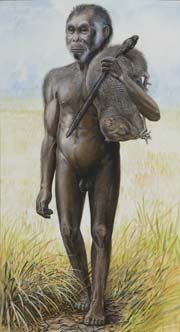
(Image: National Geographic)
The discovery of the remains of a previously unknown member of our own genus, Homo, on the remote Indonesian island of Flores is creating quite a stir. And rightly so: Homo floresiensis is a genuinely delightful find. Measuring a mere one metre in height, the remains of the first H. floresiensis to be uncovered were originally thought to be those of a child, but turned out to be the remains of a fully grown adult. Inevitably, perhaps, our new-found and long-lost cousins have been nicknamed 'hobbits' by publicity-savvy scientists.
Although the discovery of H. floresiensis is undeniably wonderful, it shouldn't be seen as quite the surprise that some of the media stories imply. Like any other animal, we humans have evolved. Our family tree contains numerous predecessors and cousins, but, as with many other fossil records, our own is notoriously incomplete. H. floresiensis helps us fill in an unexpected gap, but the fact that there are gaps in our knowledge should come as no surprise. What other reason is there for doing science?
But what about H. floresiensis's diminutive size? Once again, fascinating, but not entirely surprising: H. floresiensis was a mammal which lived on an isolated island. There are many examples of dwarf mammals living in such places (including the tiny elephants hunted by H. floresiensis). It is believed that evolving into diminutive forms is one way of adapting to environments containing limited resources and (not co-incidentally) few large predators.
One thing that is genuinely surprising about the recent finds, however, is where they were found—on a remote island, which could (presumably) only be reached by boat—and the fact that they were found alongside finely crafted stone tools. This implies that H. floresiensis and its (and our) likely ancestor, Homo erectus, were cleverer than we might have expected.
But by far the most remarkable thing that the discovery of H. floresiensis has taught us is just how recently we H. sapiens had a living, breathing cousin sharing our planet. The most recent Flores finds have been dated at around just 18,000 years old. By that time our other close cousins, the Neanderthals (Homo neaderthalensis) were long since extinct, and H. sapiens had already spread across much of the planet. Intriguingly, H. sapiens is believed to have reached Flores at least 35,000 years ago, so we and our diminutive cousins almost certainly saw each other in the flesh. Indeed, it is already being speculated that H. floresiensis might have lived on into modern times, becoming the tiny Ebu Gogo people of Flores Islanders' legends. Even wilder speculation has it that H. floresiensis might still survive in some hidden corner of the world.
Now that really would be something.
But remarkable though these H. floresiensis were (and maybe, just maybe, still are) there is one thing they most definitely were not: they might have been diminutive in our eyes, but let's not belittle them even further by referring to them as hobbits. Yes, I know it's just a catchy tag to label them with, and it's much more convenient and easier to spell than Homo floresiensis, but why don't we stick with (some would say sexist) tradition, and name them in English after the place they were discovered? Flores Man.
Lets just call them humans.
http://www.theinquirer.net/gb/inquirer/news/2008/03/06/hobbits-declared-human
As I'm sure anyone interested in the subject will be well-aware, the jury is still very much out on that one. Whatever the eventual result, it's all good science.
Incidentally, John Hawks has a pretty clear refutation of the recent cretinism claims here.